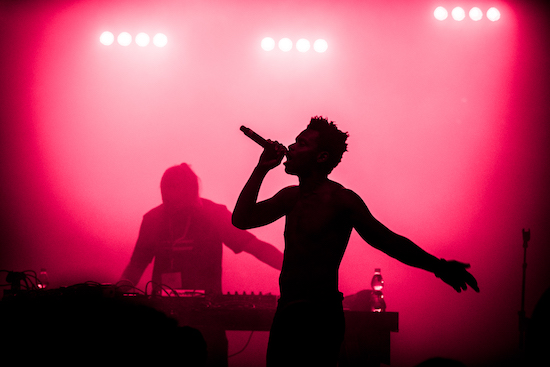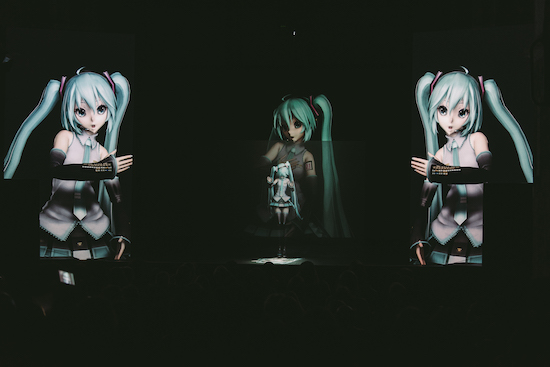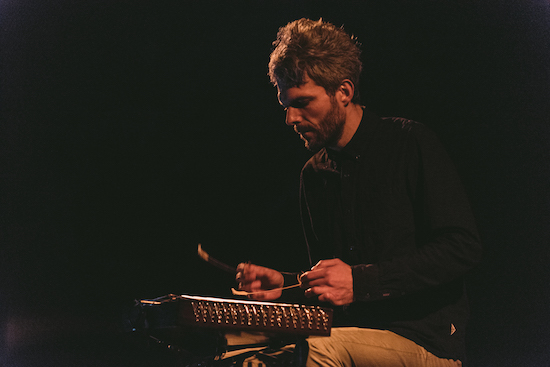Good curation trumps everything
Nestled almost out of sight in the heart of Lower Austria along the banks of the Danube, the town of Krems is hardly the sort of place one would normally expect to find a festival loftily aiming to ‘redefine the arts’. The town comprises one long picturesque series of baroque buildings, punctuated only by the strangely out of place grey monoliths of a modern art gallery, and a high security prison (where Austria’s most infamous prisoner Josef Fritzl is spending his life sentence). The streets are populated by well-to-do Austrians smiling at each other in recognition as they pass in the streets, and the sun shines throughout our entire visit. In its second decade of existence, Donaufestival (‘Donau’ being the German word for the Danube) is losing none of its relevance, and if anything it’s assembling a bolder and more challenging lineup than ever before.
Across two weekends, the timetable on each day of the festival is curated as if by a chef, themed in flavour without being oversaturating. The opening Friday boasts four black artists at forefront of their fields (RP Boo, Gaika, Mbongwana Star, and Hieroglyphic Being) while Saturday hosts MENA-originated musicians Maurice Louca, EEK featuring Islam Chipsy, and Fatima al Qadiri, plus a set of Persian-tinged sonics from Stefan Fraunberger. The following weekend also hosts several LGBT artists, including gay rapper Le1f, and trans artist Tara Transitory. Living in Austria, the consistent presence of the refugee crisis and the growth of ill-informed xenophobia seems tangible on a daily basis. Daily headlines detail the gradual rise of the FPÖ (Austria’s less nuanced and cosy equivalent to UKIP), while befriending an asylum seeker from a war-torn country seems a less and less seldom occurrence. In an atmosphere of such cultural dissonance, the diverse lineup of foreign and LGBT artists at Donaufestival is far from tokenism; it’s a level-headed and utterly essential diamond in the rough.
Just about anything can be a performance
Our first stop is to a sound installation by Venezuelan guitarist and sound artist Rubén D’Hers, Quebrada Escondido. It comprises 15 acoustic guitars lying on the floor with small electric hand fans dangling just above the strings; hanging from the ceiling by wire, tickling notes and butterfly drones out of the guitars. Later on, the Austrian premiere for Japanese virtual pop star Hatsune Miku presents another man-made organism. Perhaps foolishly expecting crowd pleasing J-pop, we’re taken aback by a dreamy collage over several screens surrounding the holographic Hatsune Miku. The performance only features two or three ‘songs’ performed by the virtual singer, and the rest of the show is an artful mix of surreal abstract visuals, a carpet bomb of celeb-style images of Miku, and snippets of interviews with the tech companies behind the project (their pre-recorded speech is oddly channelled strangely through Miku herself, as if possessed). The lyrics of one song quite comically have Miku praising and name-checking her creators ("thank you Yamaha!") while one interviewee describes her ghostly, slave-like existence, somewhat guiltily comparing her to a sex worker. The score by Laurel Halo (who is in attendance triggering sounds) and a host of other collaborators is an aptly strange and convulsive mix of further reaching avant-electronica tropes with a little tiara-like sheen lifted from J-pop. Precisely where the affair falls on the spectrum between concert and film installation remains ambiguous, as does Hatsune Miku’s raison d’être.

Mythologise yourself
Much of the first evening is reserved for black artists trailblazing in their respective fields. Congolese band Mbongwana Star break from the spacier grooves of their record for a hard rocking set, while a pair of Chicago’s finest – space techno shaman Hieroglyphic Being and footwork godfather RP Boo – deliver an insanely fun hour of beats apiece. Hieroglyphic Being eschews the shades of jazz from his recent collaborative opus, delivering his standard fiery analogue techno and acid arpeggiation at its very finest. The crowd of energetic young Austrians barely let up, solidly taking up the dancing challenge presented by RP Boo’s blink-and-you’ll-miss-it array of samples and razor sharp grooves. In the larger space of the town hall though, Gaika’s performance is easily the highlight of the day. The still relatively new artist (his second album SECURITY only just dropped) already has Kanye’s flair for self-mythologizing down to a capital T, yelling auto-tuned agitprop about being whoever the fuck he wants to be while silhouetted godlike in light and smoke. The Brixton native’s demonic autotune vocals are clearly way more rooted in dancehall and toasting than to American rap, and the offbeat get aptly signposted amidst the music’s dark haze. The rumbling backdrops of tunes like ‘GKZ’ and ‘Knuckleduster’ put the room’s huge PA through one of their biggest workouts of the entire festival (only topped by Tim Hecker’s explosive low-end the following weekend), but the sheer attack is all part of Gaika’s plan; fulfilling his own prophecy of himself as superhuman MC. Hopefully it works out, as Gaika really should be heading up the ranks sooner rather than later, upwards to greater things. Omar Souleyman closes out the night with a similarly triumphant set of 4/4 worshipping dabke. As an added bonus, a Syrian wedding singer drawing one of the biggest crowds of the festival definitely feels like a rock solid middle finger to an increasingly Islamophobic mainstream.
There’s more to churches than wafer distribution
Krems’ striking Minorites Church houses several of the more sonically severe and darker acts on the bill, and Stefan Fraunberger’s set in the echoey stone setting is the very best. This Austrian artist is also a linguist, fluent in several Middle Eastern languages, and finding inspiration from his insight into old Arabic text in the case of a newly commissioned work برزخ – at the gates of the union. The piece is performed by Fraunberger playing a Persian dulcimer (a Santur) with a handful of field recordings from Syria, Pakistan and Iraq mixed in, and the title (pronounced barzakh) refers to the ‘barrier between the physical and spiritual worlds’. The billowy array of scrapes, plucks, and tickles he puts the dulcimer’s strings through is uniformly beautiful, diverging a couple of times away in favour of booming doom that lingers in the slowly decaying sonics of the space. The amplified strings veer between melodies and noise washes, and never stop being engaging and provocative for over an hour. Entering the room feels quite like a barrier between worlds too. It’s almost entirely pitch black aside from the gentle light on Fraunberger seated on a small stage in the middle of the crowd. It takes several minutes for one’s eyes to adjust, so new audience members can be watched walking in from the outside, temporarily blind. They shuffle slowly, arms outstretched, helpless and ghostlike in the darkness. Fraunberger’s soundtrack couldn’t be more appropriate.
French artist Pierre Bastien’s performance in the church is another high point, closer to flea circus than ceremony. Bastien’s been making mechanical music machines out of meccano, old turntable motors, and lots else since the 1980s. His setup is almost like a strange steampunk doll’s house, propped on a table on stage, and projected via live camera feed for us all to observe as Bastien switches out and fiddles with the rotating parts, crafting incidental rhythms and toy sounds amplified into giant thuds. He backs up the machine on a variety of instruments, including a strange mini harp, bowed and plucked nails in a block of wood, and some beautiful pocket trumpet playing. The finale sees Bastien place a strange appendage on to the trumpet; a giant straw poking out the end into a mic’d up plastic cup of water. The lullaby-esque melody comes out bubbly, dreamlike, and oddly humorous.
More is more
A delayed flight for Islam Chipsy & EEK shuffles the lineup, bringing fellow Egyptian musician Maurice Louca forward to late afternoon. His distinct form of psychedelic shaabi perfected on Salute the Parrot is a thrill to behold. His array of loops and synths now augmented by live bassist and a drummer, the music boasts many heavier rocking sections. It’s a slower building and more varied beast than the likes of Islam Chipsy, but Louca’s choice to add live musicians has injected much of that fiery energy into his sound. Islam Chipsy & EEK’s infamous keyboard and drum pyrotechnics later close out the night. It’s gloriously repetitive, and the trio never stop grinning, teasing the crowd with countless false endings. One wonders where they keep their energy reserves. Somehow the trio maintain superhuman drive, lightning drums, and flickering keyboard stabs for well over an hour.
The ever amazing Hyperdub gets represented by Kode9 and Fatima al Qadiri, both of whom provide straight up groove-heavy sets of bangers, expertly paying off every prolonged moment with a filleted slice of hefty fast-paced juke, techno, footwork, future grime, and everything in-between. Maximalism is the aesthetic of the day, from Louca and Chipsy’s pair of Cairo street parties, to the Hyperdub duo’s relentless seamless sets (Kode9 seems to drop a new sample or track every 15 bleedin’ seconds! – it’s the total opposite of his pensive Void album). Later in the town hall Evian Christ is utterly invisible behind an opaque wall of fog and blinding strobes that don’t let up for the entire performance, leaving everybody in the place blinking and rubbing their eyes. The dense multi-layered body of sound he summons is no less blinding, somehow integrating totemistic samples of cheesy pop (his reconfiguration of t.A.T.u’s ‘All the Things She Said’ is a highpoint) and Ibiza trance classics into a lattice of brutally noisy beats. Paired with unrelenting strobing lights, such dense and heavy music –that is nonetheless full of cultural signposts – leaves the brain little space for thinking. All that’s left is sheer visceral ass shaking. Tim Hecker the following weekend fills the same space with an even denser fog. The ever popular Canadian composer crafts an exceptionally beautiful collage of themes from his last few records (including plenty from his latest Love Streams), accented by a setup of coloured striplights that shade the fog in purples, blues, and reds. The performance comes to a head with a mind-clearing finale of gigantic rumbling tones that threatens to shake the building to pieces. It feels like it’s difficult to get much more of anything than the amount of sound and inescapable stimulation served up by Hecker. The next morning seemingly takes place in another universe as we wake up to breakfast in the serene baroque town, flanked by vineyards bathed in sunshine and birdsong.

Art is a safe space. The world is not.
Mogwai perform seated before a projection of Mark Cousin’s BBC Storyville documentary, Atomic. The free-flowing documentary tells the story of nuclear power from the end of the Second World War all the way into a fateful future with nothing more than stock footage and Mogwai’s new score. It’s clearly a subject close to the band’s heart (they were vocally in favour of a ‘Yes’ vote in the Scottish referendum, specifically discussing the evil of Trident as something to jettison not just from Scotland, but from the planet), and their commitment pushes Atomic further than any other live film-scoring project ever before. The closeness of the disturbing imagery is almost too much to take through watery eyes. The finale unwinds into a veritable nuclear blast of shrieking guitars and feedback; a warning of the hellfire that could still be unleashed, juxtaposed with the documentary’s closing remarks that over 15,000 nuclear warheads are still on Earth today. It could well be the finest piece of work Mogwai have ever done, filled with their standard forlorn beauty, yet boiling over into white-fisted rage. Though probably the best, Mogwai’s is also amongst the least outwardly adventurous sets of the entire festival. Guitar melodies and lethargic beats unfurling into symphonic climaxes, arpeggios weaving a filmic lattice of forward motion – it’s familiar but no less potent for it. By comparison, the set of cubist electronics by Texan producer Lotic teases with us, never quite slotting into a groove, yanking away at our preconceptions about dance music and cadence, rendering the genre unrecognisable even by its dental records. If the aim of Donaufestival is to redefine art, then the oceanic gap they present us with – between Lotic’s futurist deconstruction of musical language and Mogwai’s mastery of musical syntax and cadences as ancient as the human ear – is perhaps the very definition of how all-encompassing the scope of art and music is. New emotions are getting mapped out by artists before we can even feel them.
Of the several non-musical events at the festival, a video installation filmed in Iran by artist Marlies Pöschl and musician Manuel Riegler is the simplest and most invigorating. In a shady hidden away space near a main stage, projections across three screens document an underground network of all female Yoga, Zumba, and similar classes of questionable legality held in secret in private residences in the Iranian capital. Unable to film the classes themselves due to privacy reasons, Pöschl presents a series of gently moving images from the spaces – a set of yoga mats, a laser light idly drawing lines in the darkness for nobody at an empty Zumba studio, a softly swaying punchbag. Riegler’s audio recordings of heaving breathing, instructions, and bodily noises from the actual classes themselves is later layered over the top, leaving it up to us to envisage the classes themselves, and the presumably countless stories from Iran’s many secret places. After visiting the installation, we walk straight into the centre of RP Boo’s ferocious footwork set. He’s now flanked on stage by a pair of girls plucked from the crowd, and they’re working their feet like mad, reminding us all that we’re free to dance with them.
Listen below to Tristan Bath’s radio show, with Mogwai and Maurice Louca, recorded at Donaufestival.


